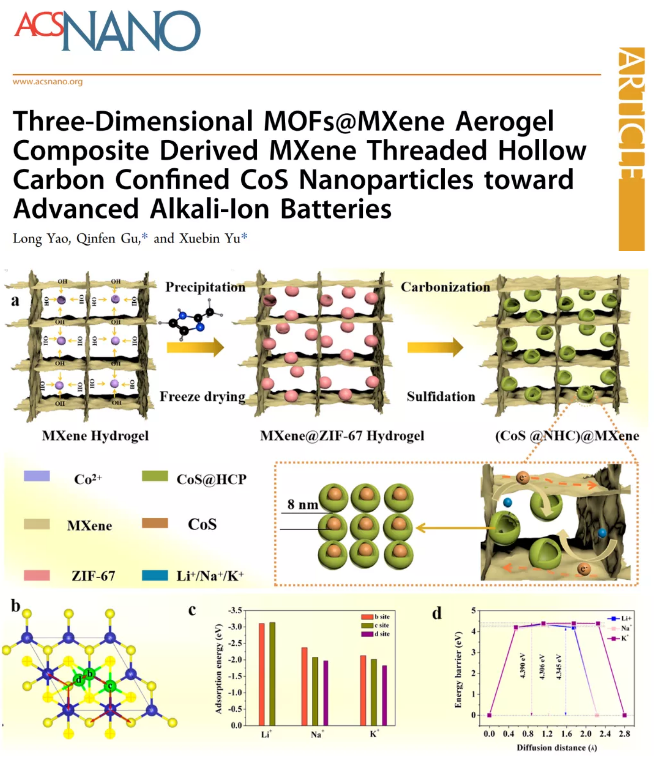
hotline:
17715390137
Tel/Wechat:
18101240246 (Technology)
0512-68565571
Email:mxenes@163.com (Sales Engineer)bkxc.bonnie@gmail.com
Scan the code to follow or search the official account on WeChat:
2D Materials Fronrier After paying attention,
click on the lower right corner to contact us,
Enter enterprise WeChat.
Professional Services Online

 MXene is an emerging potential two-dimensional material. It is widely used in energy, electromagnetic interference shielding, oxygen evolution reaction and other fields due to its hydrophilic surface, controllable flexible layer spacing, high metal conductivity, and rich surface functional groups. . However, like most two-dimensional materials, the stacking of MXene nanosheets is inevitable due to van der Waals interaction and hydrogen bonding between adjacent nanosheets. In recent years, despite many works by designing a three-dimensional MXene aerogel to effectively suppress the re-stacking of nanosheets, it also has a rich porous structure, ultra-low density, flexibility and excellent performance. Unfortunately, in general, the reported MXene aerogels are mainly composed of macropores, rather than well-defined micropores or mesopores, which will greatly limit their specific surface area and mass transfer. In view of this, Professor Yu Xuebin from Fudan University and others reported a MOFs@MXene aerogel structure, in which MOF particles formed in situ can effectively prevent the accumulation of MXene, making the structure a three-dimensional (3D) hierarchical Porous conductive network shape and ultra-light characteristics. Subsequently, a 3D porous MXene aerogel threaded hollow CoS nanobox composite ((CoS NP @ NHC)@MXene) derived from the MOFs @ MXene aerogel precursor was further synthesized, due to this highly interconnected MXene network And layered porous structure combined with ultra-fine nano-crystallization. The material has a high degree of electrochemical activity and excellent electronic and ion transport properties. The research was published in the latest issue of ACS Nano with a paper titled "Three-Dimensional MOFs@MXene Aerogel Composite Derived MXene Threaded Hollow Carbon Confined CoS Nanoparticles toward Advanced Alkali-Ion Batteries".
MXene is an emerging potential two-dimensional material. It is widely used in energy, electromagnetic interference shielding, oxygen evolution reaction and other fields due to its hydrophilic surface, controllable flexible layer spacing, high metal conductivity, and rich surface functional groups. . However, like most two-dimensional materials, the stacking of MXene nanosheets is inevitable due to van der Waals interaction and hydrogen bonding between adjacent nanosheets. In recent years, despite many works by designing a three-dimensional MXene aerogel to effectively suppress the re-stacking of nanosheets, it also has a rich porous structure, ultra-low density, flexibility and excellent performance. Unfortunately, in general, the reported MXene aerogels are mainly composed of macropores, rather than well-defined micropores or mesopores, which will greatly limit their specific surface area and mass transfer. In view of this, Professor Yu Xuebin from Fudan University and others reported a MOFs@MXene aerogel structure, in which MOF particles formed in situ can effectively prevent the accumulation of MXene, making the structure a three-dimensional (3D) hierarchical Porous conductive network shape and ultra-light characteristics. Subsequently, a 3D porous MXene aerogel threaded hollow CoS nanobox composite ((CoS NP @ NHC)@MXene) derived from the MOFs @ MXene aerogel precursor was further synthesized, due to this highly interconnected MXene network And layered porous structure combined with ultra-fine nano-crystallization. The material has a high degree of electrochemical activity and excellent electronic and ion transport properties. The research was published in the latest issue of ACS Nano with a paper titled "Three-Dimensional MOFs@MXene Aerogel Composite Derived MXene Threaded Hollow Carbon Confined CoS Nanoparticles toward Advanced Alkali-Ion Batteries".

Highlights of the article: (1) Thanks to the synergistic composition, the (CoS NP @ NHC) @MXene composite material has excellent electrochemical performance in lithium ion batteries (LIB), sodium ion batteries (SIB) and potassium ions. For LIB, the capacity is 1145.9 mAh g-1 after 800 cycles at a current density of 1 A g-1, and 574.1 mAh g-1 after 1,000 cycles at a current density of 5 A g-1. For SIB, at a current density of 2 A g-1, the capacity for 650 cycles is 420 mAh g-1. For PIB, at a current density of 2 A g-1, the capacity is 210 mAh g-1 after 500 cycles, both showing excellent cycle stability and high capacity. (2) Theoretical calculations show that CoS has stable chemical adsorption to all Li/Na/K ions. Among the three alkali ions, the adsorption of Li ions on the surface of CoS (001) is the strongest, indicating that it has strong ion surface adsorption kinetics. In addition, the diffusion barriers of these three ions on the CoS surface are all 4.3-4.5 eV. The diffusion energy barrier is approximately twice the adsorption energy, which indicates that the diffusion rate of the ion surface is low. The reaction mechanism is mainly divided into two steps. The first is the adsorption of ions on the surface of CoS nanoparticles, and then the conversion reaction of CoS with alkali ions. (3) Under high load, (CoS NP @ NHC) @Mxene shows very high volume energy and power density, for LIB (power density is 26 kW L-1 when the energy density is 2391 Wh L-1) , For NIB (power density is 24 kW L-1 when energy density is 3706 Wh L-1), for PIB (power density is 24 kW L-1 when energy density is 777 Wh L-1).

Source of information: Frontiers of Polymer Science
This information is from the Internet for academic exchanges. If there is any infringement, please contact us and delete it immediately

| Reminder: Beijing Beike New Material Technology Co., Ltd. supplies products only for scientific research, not for humans |
| All rights reserved © 2019 beijing beike new material Technology Co., Ltd 京ICP备16054715-2号 |